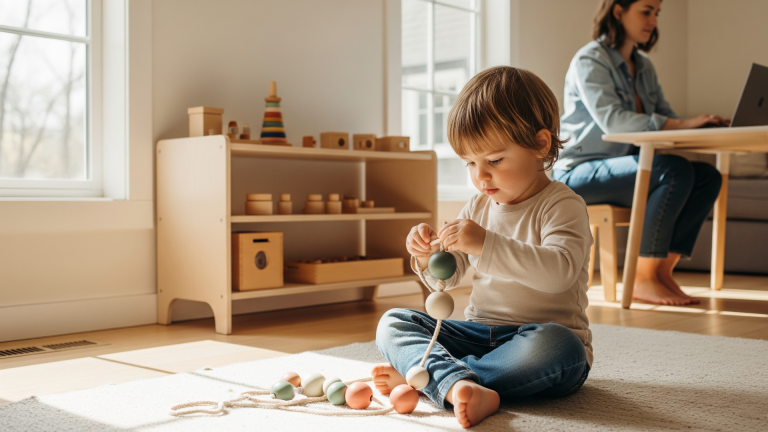What Is Good Parenting? 10 Principles Backed by Research
Every parent asks it, usually late at night: “Am I a good parent?”
Not “perfect.” Good. As in: consistent, steady, and raising a human who can stand on their own.
Here’s the short version: good parenting isn’t a personality type or a perfect routine. It’s a set of repeatable principles that hold up under pressure and are backed by solid research. In this guide, you’ll get clear definitions, what the science actually supports, and simple ways to use these ideas at home.
This isn’t philosophy class. It’s a field guide. Steal what works today.
What Does “Good Parenting” Mean?
Working definition: Good parenting is the ongoing, intentional practice of meeting a child’s core needs (physical and emotional), teaching skills through guidance and limits, and maintaining a relationship strong enough to carry real influence as kids grow.
Responsive, back-and-forth interactions—think conversational “serve and return”—are the foundation. Those daily micro-exchanges wire the brain for attention, language, and self-control, which is why relationship quality is not fluff; it’s infrastructure.
Why Good Parenting Matters
Good parenting isn’t about producing a perfect report card or a college resume. It’s about building lifelong capacities:
If your house feels chaotic, you don’t need a new personality. You need two or three rules everyone can remember when they’re tired.
The 10 Core Principles of Good Parenting
Each principle below includes what it means, why it matters, and how to use it today.
1) Love & Affection
What it is: Regular warmth, attention, and repair. You notice, you listen, you hug, and when you blow it, you circle back.
Why it matters: Responsive “serve and return” moments build brain architecture for learning and self-control. Kids who feel safe with you can actually hear you.
How to use it:
Micro-check: Love does not cancel limits; it makes them stick.
2) Consistency
What it is: Predictable routines, clear rules, steady follow-through.
Why it matters: Kids cooperate more when expectations stop moving. Home becomes safer and less exhausting.
How to use it:
Reset line: If a rule changes daily, the new rule is randomness.
3) Setting Boundaries
What it is: Limits that protect people, property, and priorities (sleep, school, health).
Why it matters: Boundaries are the rails kids hold while they learn self-control. Even major pediatric groups warn that harsh punishments (spanking, shaming) don’t teach better behavior and carry risks of harm; use calm, teaching-focused discipline instead. (AAP Publications)
How to use it:
And don’t forget that boundaries apply to tech use too. If screens are part of the struggle in your home, here’s a guide on setting digital boundaries that actually stick.
4) Listening
What it is: You take in your child’s perspective before you decide. Not a debate, but a real hearing.
Why it matters: Being heard lowers defensiveness and gives you better data. It also models the communication you want in return.
How to use it:
5) Positive Discipline
What it is: Discipline that teaches. You reinforce what you want more of, coach skills, and use non-violent consequences that fit the behavior.
Why it matters: Kids learn faster when we teach the replacement behavior. Health agencies provide age-by-age guidance that prioritizes safety, routines, and skill-building over punishment.
How to use it:
For a deeper breakdown of this approach and how to apply it, see our full guide on What Is Positive Discipline? (And Why This Proven Method Works Better Than Punishment).
6) Encouraging Independence
What it is: Letting kids try, fail small, and try again—while you spot them.
Why it matters: Independence builds competence and real confidence. Kids who do for themselves believe they can.
How to use it:
7) Modeling Respect
What it is: You act the way you want your child to act—especially under stress.
Why it matters: Kids imitate your tone, not your speeches. Respect during conflict teaches self-control and empathy.
How to use it:
8) Building Resilience
What it is: Helping kids face tough things with support, not rescuing them from all discomfort.
Why it matters: Struggle + support = growth. National Academies’ synthesis highlights how nurturing relationships and guided challenges build the skills that buffer stress.
How to use it:
9) Teaching Values
What it is: Making family values visible in decisions, not just wall art.
Why it matters: Kids need a moral compass to navigate peers, media, and the wider world. Clear values simplify choices.
How to use it:
10) Supporting Growth
What it is: You adjust expectations to developmental stage and temperament, and you keep learning as a parent.
Why it matters: A strategy can be solid and still be the wrong fit for this child at this age. Good parenting adapts.
How to use it:
Don’t “try harder.” Try smaller. Shrink the step until it happens.
What Good Parenting Is Not
How to Apply These Principles Day-to-Day
Below are concrete plays you can run this week. They’re short by design. You’re busy.
Morning routine (any age)
Handling tantrums (toddlers + preschool)
(For age-aligned ideas across infancy to teens, see the CDC’s Positive Parenting Tips.) CDC
Sibling conflict
Homework resistance (school-age)
Curfew slip (teens)
Screens at home
If you’re not sure how much screen time really counts—or what the research says about it—our explainer on What Is Screen Time, Really? breaks it down.
Family meeting (15 minutes, weekly)
If a routine keeps failing, the routine is too big. Shrink steps until they succeed on a bad day.
Frequently Asked Questions
Is “authoritative” the same as good parenting?
Authoritative parenting (warmth + firm limits + autonomy support) is often associated with better outcomes on average, including fewer behavior problems and better academics. Meta-analytic reviews emphasize the value of warmth, behavioral control, and autonomy granting, while showing that context and culture matter. Translation: the principles are solid, but you still tailor to your kid and family.
Do I have to avoid all consequences?
No. Avoid harsh punishment (spanking, shaming), which doesn’t teach lasting skills and carries risks. Use natural (what happens on its own) and logical (related, respectful, reasonable) consequences paired with coaching the right behavior. (AAP Publications)
What if I yelled yesterday?
Repair > regret. Own it in one sentence, name your next-step strategy, reconnect, and move on. That models accountability better than a lecture ever will.
10 Principles, 10 Quick Tips (Cheat Sheet)
What Good Parenting Is NOT (Recap)
Kids don’t need a perfect parent. They need a predictable one.
Conclusion
Good parenting is a handful of repeatable moves you can run every day: connect, set the limit, teach the skill, and follow through—kindly and consistently. If you hold to the principles, the tactics are easy to swap as your child grows.
You’re not auditioning for “perfect.” You’re building a stable, loving system your child can grow inside. That’s good parenting.








